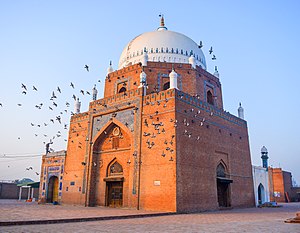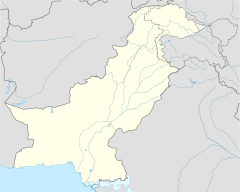Shrine of Bahauddin Zakariya
| بہاؤ الدین زکریا درگاہ | |

The shrine of Bahauddin Zakariya is the prototype for the development of southern Punjab's distinct style of architecture
|
|
|
Location in Punjab, Pakistan
Location in Punjab, Pakistan
|
|
| Coordinates | Coordinates: 30°12′02″N 71°28′35″E / 30.20056°N 71.47639°E |
|---|---|
| Location | Multan, Punjab, Pakistan |
| Type | Sufi shrine |
| Completion date | 1262 C.E. |
The Shrine of Bahauddin Zakariya (Urdu: بہاؤ الدین زکریا درگاہ) is a 13th century shrine located in the city of Multan, in Pakistan's Punjab province. The tomb is dedicated to the Muslim mystic Bahauddin Zakariya, founder of the Suhrawardiyya order of Sufism. It considered to be one of the most important shrines in southern Punjab province, and is the prototype for Multan's distinct architectural style.
The shrine is located in central Multan, immediately north of its old walled city. The shrine stands next to the remains of the ancient Hindu Prahladpuri Temple.
By the 13th century, the belief that the spiritual powers of great Sufi saints were attached to their burial sites was widespread in the Muslim world, and so a shrine was built to commemorate the burial site of Bahauddin Zakariya. In keeping with Sufi tradition in Punjab, the shrine's influence is augmented by smaller shrines spread throughout the region around Multan. These secondary shrines form a wilayat, or a "spiritual territory" of the primary shrine. As home to the primary shrine, Multan serves as the capital of Bahauddin Zakariya's wilayat. The shrine's wilayat is noted to border the spiritual territory of the Shrine of Baba Farid, based in Pakpattan.
The shrine was built in 1262 before the death of Zakariya in 1268. Unusual for a dervish, the structure was paid for at the expense of Bahauddin Zakariya - highlighting his unique financial independence.
Dara Shikoh unsuccessfully attempted to win the loyalty of Multan's citizens by donating 25,000 Rupees to the shrine following his defeat by his brother at the Battle of Samugarh in 1658.
...
Wikipedia


